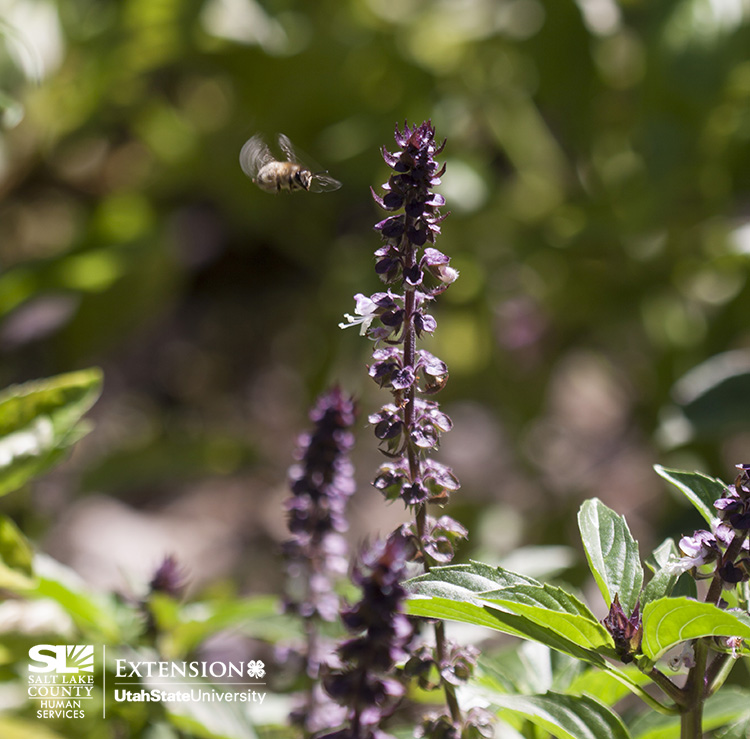- Plant plants that bloom throughout the growing season and hence provide a continuous supply of pollen and nectar. When selecting plants at the nursery, make sure to not only purchase plants that bloom in the spring, but also plants that bloom in the summer, and plants that bloom in the fall so pollinators have a nearby food source all season long.
- Incorporate native plants into flower beds throughout your yard. Some of the best pollinator plants are Utah native plants because they produce high quality pollen and nectar. Read the USU Extension fact sheet Gardening for Native Bees in Utah and Beyond for an extensive listing of pollinator plants that grow well in Utah.
- Bees are attracted to the sound of running water so install a small fountain or retrofit a birdbath with a bubbler to provide a fresh water source. It is important to provide bees a clean water source housed in a container with gently sloping sides so they do not fall into the container and drown.
- Plant pollinator plants with various bloom colors and flower shapes to attract a diverse range of pollinators. Bees are highly attracted to yellow, blue, and purple colored blooms but do not forget to plant red flowers, like firecracker penstemon (Penstemon eatonii), to attract other garden visitors like hummingbirds! Good plants for attracting butterflies include asters, bee balms, butterfly bush, butterfly weed, cosmos, marigolds, rubber rabbitbrush, sunflowers, and zinnias.
- Plant more herb plants than you plan to consume and allow some of your herbs to bloom for bees and butterflies. Many herbs provide an excellent source of pollen and nectar. A few of my personal favorites are sage, lavender, and mint (always planted in a container, of course).
- Incorporate flowers throughout your vegetable garden that attract pollinators and other beneficial insects. Flowers from plants such as cosmos, zinnias, and sunflowers not only look beautiful next to vegetable plants; their blooms also provide pollinators with a great food source.
- Bees have poor vision so they are more likely to locate pollinator plants if they are planted in large masses (ideally at least 3 feet by 3 feet). Avoid chaotic displays of flower types and instead, group like plants together to form large masses.
- Provide bees and butterflies a broad plant selection of at least 15 to 25 different plant species. Some popular annuals, like pansies and petunias, do not provide quality pollen and nectar for bees and butterflies so do not include them in your tally of pollinator plants.
- Plant at least one member of the milkweed family, like butterfly weed (Asclepias tuberosa), to attract the magnificent Monarch butterfly. Females lay their eggs on milkweed plants and hatched larva exclusively feed on plants from this genus.
- Avoid spraying pesticides toxic to bees and butterflies around pollinator plants in bloom. Always read and follow the product label before applying. As an alternative, learn about alternative integrated pest management (IPM) techniques for controlling garden pests. For more information on IPM, visit the Utah pests website, utahpests.usu.edu.




2 Responses to Top 10 Ways to Attract Bees & Butterflies to Your Yard
I only know of a handful of studies for the pollen quality of native Utah plants. Pollen quality in general is a very poorly studied part of bee health.
If you know of any research on this subject that would help my own studies into providing healthy pollen for honeybees I would very much apreciate good references.
Alex-
I consulted with the expert, Dr. Jim Cain from the USDA-ARS Bee Biology and Systematics Lab in Logan. Jim pointed me toward a couple of publications he completed with a colleague.
Roulston, T, J. H. Cane and S. L. Buchmann. 2000. What governs protein content of pollen: Pollinator preferences, pollen-pistil interactions, or phylogeny? Ecological Monographs 70(4):617-643.
Roulston, T, and J. H. Cane. 2000. Pollen nutritional content and digestibility for animals. Plant System. and Evol.. 222: 187-209.
He also made the following comment:
“Insect-pollinated plants are underrepresented because it takes an 1/8 tsp of pure pollen (or so) for the protein assay. If you start trying to manually collect that from most any legume flower, you will quickly see that it is an onerous job! Honey bee pollen pellets would be great, except that their dry weight can include up to 30% nectar sugars, so % protein estimates from them are up to 30% off. The easiest approach is to watch what bees choose to use and provide more! Most legumes are a sure bet.”
Hopefully this helps with your studies and I appreciate your interest, and Jim’s expertise, in this comment posting – good luck!